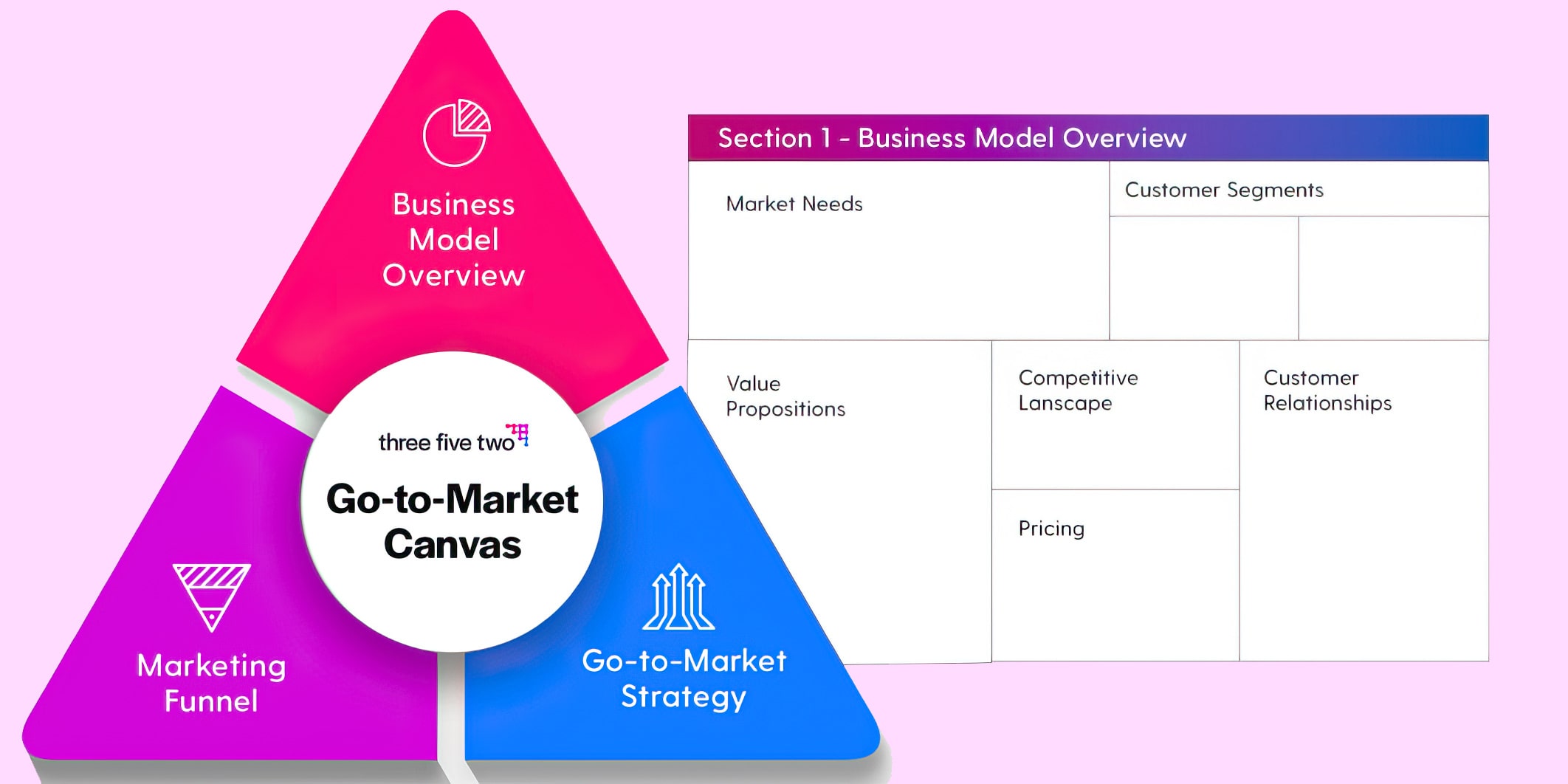
Go-to-Market Strategy Canvas Template
The Go-to-Market Canvas is a tool our teams at Three Five Two developed for visualizing and aligning on taking new products and services to market. Our product managers, marketing strategists, and data analysts have used it to launch products for Fortune 500 companies and startups alike.
What is a Go-To-Market Strategy?
You’ve built a product or a business or a suite of services to meet a specific market need. But you haven’t yet launched that product to the world. This is where a go-to-market strategy comes in.
A go-to-market strategy helps start-ups, new ventures, and established companies think about taking net new products and services to a market that may not yet exist or is still in its infancy. A strong GTM strategy will go beyond just outlining a target audience, marketing plan, and sales strategy – it will reveal the overarching strategy that will give you a competitive advantage in your particular market.
“One thing that’s missing from the traditional Business Model Canvas is the question, ‘Does my product/business model enable competitive advantage that will enable you to win in the marketplace?’ To me, that’s a key question to answer, but one that often gets overlooked,” says Steve Borengasser, Business Lead at Three Five Two.
Gaining a competitive advantage, getting on the fastest path to product-market fit, and laser-focusing on how to capture revenue from your target audience is always our goal when working with our clients at Three Five Two. Our Go-To-Market-Strategy Canvas is what helps us get there.
Why use the Go-To-Market Canvas?
The Go-to-Market Strategy Canvas is your guiding star: a living, breathing document that will evolve as you test and learn. Its job is to align all your internal stakeholders around what you want to accomplish and what you need to consider when bringing a new product, service, or venture to market.
“One of the number one barriers for us to getting products into market isn’t pricing strategy, or not understanding your target market – it’s getting internal alignment and buy-in of our launch strategy,” said Jess Larson, Director of Product Management at Three Five Two. “Tools like the Go-to-Market Strategy Canvas are so critical because they force us to put words to our assumptions and ideas. So many times we get in a room with teams who think they’re on the same page, but once we make our ideas explicit, it becomes really easy to see where misalignment exists, from an executive level all the way down to the execution team.”
The Go-to-Market Strategy Canvas doesn’t provide every detail about your marketing execution plan. You’ll design those pieces after you’ve achieved internal stakeholder alignment on how you will market using this canvas.
For the best results, pair your go-to-market strategy with a Learning Agenda outlining what you need to learn about your customers, market, and product adoption once in market. Click here for a free template of Three Five Two’s Learning Agenda.
Who should use this canvas?
Startups, SMBs, Mid Market, Enterprise New Venture. Product teams, Marketing teams, Business teams. This tool is for everyone.
Getting Started
The Go-to-Market Canvas focuses on three core areas:
(1) your business model and the value you create for your market; (2) your go-to-market strategy, position, outcomes, and how you’ll measure success; and (3) Pirate Metrics framework for understanding and planning your customer journey at each stage of the marketing funnel.
When filling out the different areas, remember, this needs to be based on the work your teams (product strategy, research, design, development) have done to get to this point.
Your canvas should be:
- Easy to understand
- Focused – think phrases, not paragraphs
- Flexible – can you quickly pivot as you learn?
- Customer-focused and informed by both qualitative and quantitative data
- Connected – show how the pieces of the model work together
Fill out your own Go-to-Market Strategy Canvas Template in Google Sheets or Miro.
Business Overview


The left side of this section focuses on your business or product and its market position.
The right side of this section focuses on our customers or users and how we might think about understanding and defining them.

Marketing requires a fundamental understanding of your business strategy and goals, and your go-to-market strategy needs to align to that higher order.
Market Need
The problem we are trying to solve.
In this section, you need to answer the What, the Why, and the Who. What’s the important/urgent/frequent problem we are solving? Why does this problem exist? What’s the opportunity and the trend creating the opportunity? Why is it happening? Who is the market we are serving? Is this a new market? An existing market within which we need to differentiate ourselves? Such a critical step, but product teams often build stuff no one wants or requested. Be clear on what needs you are solving.
Value Proposition
This is the value of the product or service we deliver, from its benefits to how unique our differentiation is in the market. Each customer segment will likely have its specific value proposition based on the particular need you satisfy. It’s why they buy or will buy from you. For example, Slack’s value prop is: “All your tools in one place”. Uber’s value proposition is clear and concise: “The Smartest Way to Get Around.”
Competitive Landscape
Your company’s position relative to its competitors.
Knowing where gaps are in the market or underserved audiences your product or service fills is the most important thing about understanding your competitors. Consider how much market share is available for the taking and from whom you need to take it. This information will help guide how you position your brand.
Pricing
Our product’s price point relative to the market and competitive landscape.
Pricing is part of your competitive and positioning strategy. You may choose to be a low-price leader or a high-end value play. Your pricing strategy needs to be tied directly to an understanding of the customer segments you are trying to attract and serve and what they perceive as the value of the product or service you provide.
Customer Segments
The users or customers you serve (ideal & actual).
Define the different segments that will benefit from your product – that may include your customers’ customers. Hypothesize who is most likely to be an early adopter of your product vs. a long-time user. If you are marketing a new product to an existing customer base, do you know your most frequent customer? Are they your most valuable customer?
Channels
How do you communicate with your customers? How do you deliver the value proposition? These are the touchpoints you use to interact with customers to deliver value. That may be through owned channels (stores, salesforce, website) or partner channels (wholesalers, affiliates). You should also start thinking about how customers want to engage with you leading up to a purchase decision, i.e., marketing channels such as search ads or display or paid social media.
Customer Relationships
Buyer journey with the company.
What type of relationship are you establishing? Map the customer journey and how we interact with our customers at each step. How do they find out about us? Make their initial purchase decision, eventually by from us. How do we keep them? How do we manage them?
Customer Pains
What user pains does our product solve?
We often talk about Jobs To Be Done or the job that our customers or users hire our product to do. So what are the pains that our product or service solves for them? And what are the friction points between them and getting the job done? These could be previous experiences, emotional or mental responses to their problem or the risk associated with solving it.
Customer Gains
What does a user gain by using our product?
These are the benefits that delight a customer when using your product, increasing the potential to adopt your value proposition and convert to a user or customer.
Go-to-Market Strategy

This is the fun part. All of these pieces align your team and your internal stakeholders to the high-level plan for going to market. This section may feel most familiar to many marketing practitioners.
Go-to-Market Overview

What do you intend to learn? How will we go about learning it? Why did you select the channels you did? What is our timeline for learning? Why are we starting where we are in the funnel?
For example, “The focus of NEW VENTURE’s go-to-market strategy during the first six months after launch will be to refine how we communicate our value proposition, drive sufficient traffic to enable product iteration, and learn more about our users. We will engage and acquire users through a series of small iterative experiments in the most promising traction channels. At the end of the launch period, we will have identified several successful traction channels and consistently be seeing first-time users complete the PRODUCT SPECIFIC experience.”
Goals
What should our go-to-market strategy accomplish?
KPIs
High-level metrics to measure our go-to-market strategy.
Primary Digital Channels
Tablestake channels we use for experiments given certain types of accounts, industries, etc.
Key Messages
What are the key messages we’ll use to move users through the various stages of the funnel?
Creative Direction
What emotion should our creative evoke? Should our creative inspire action?
MarTech
What stack do we have? Where are our gaps? How is data orchestrated across tools?
Pirate Metrics Marketing Funnel, aka “AAARRR!!!!”

This section provides deeper details about how you plan to move customers and users through Awareness >> Acquisition >> Activation >> Revenue >> Referral >> Retention funnel. For each stage, outline your Learning Objectives, your Traction Tactics, and your Growth Metrics.
Topline goal for each stage:
Awareness
Interrupt potential customers in market for a solution our product provides
Acquisition
Educate and acquire new users
Activation
Optimize funnel for users to meet our definition of activation. That ‘aha’ moment where consumers understand your value.
Referral
Get users to share their experience, refer friends and become brand advocates.
Retention
Create brand loyalty for repeat usage of our product.
Revenue
Ensure users are converting on purchases or paid services.
Learning Objectives
These derive from your Learning Agenda or test plan. Design your marketing experiments to answer these questions during each phase. Examples of learning objectives in Awareness Stage: Effective articulation of value proposition and key benefits and Refine targeting and enhance segmentation based on user data.
Traction Tactics
Traction Tactics must also align with your user or customer’s stage in the journey and ladder back to the Learning Objectives defined for that stage. Examples of Traction Tactics in Activation Stage: Email nurture series, Abandon email communications, or Retargeting.
Growth Metrics
Think about Growth Metrics in tiers. You have your primary and secondary KPIs (these ladder up to the KPIs you defined above in the Go-to-Market section). Your primary KPI will be # of referrals in the Referral phase. Secondary KPIs could be referral rate, star ratings, or organic traffic. Leading Indicators help you assess immediate progress and the likelihood of achieving your goals. Leading Indicators in the Referral phase could be survey completions, customer service interactions, or “Organic” acquisition growth.
Socializing Your Go-to-Market Canvas
You have likely tapped into your colleagues’ knowledge to define some of these pieces. That’s great. Getting early buy-in from your team will be critical to the success of your product or service launch.
Once you’ve completed your canvas, bring your stakeholders in for a walk-thru. Explain your thinking. As marketers, we represent the voice of the customer within a product team or business unit. You will need the support of your broader team in bringing both the product and the value prop to life for your customers.




